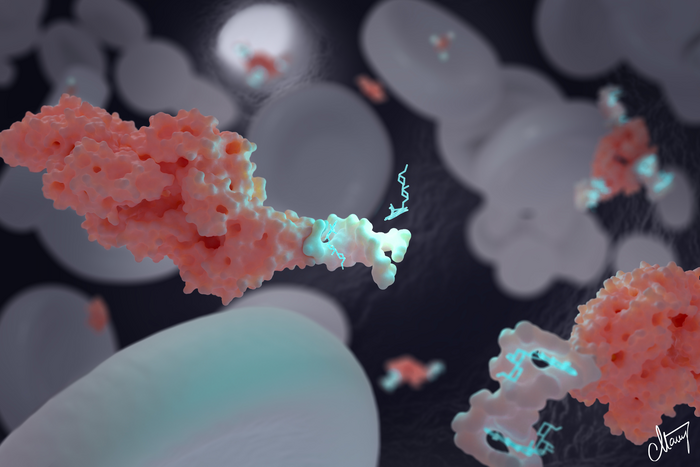DNA-based ‘nanotransporters’ revolutionize cancer treatment
A team of Canadian researchers from Université de Montréal has designed and validated a new class of drug transporters made of DNA.

[Nov 4, 2022: Julie Gazaille, University of Montreal]
The DNA-based nanotransporter developed by Alexis Vallée-Bélisle and his team can transport and deliver precise concentrations of drugs: in this picture, doxorubicin, a chemotherapeutic drug. These nanotransporters can also be attached to specific biomolecules to optimize drug distribution. Here, we see a nanotransporter (white) attached to albumin (pink) to maintain doxorubin (light blue) in blood circulation. (Credit: Illustration : Monney Medical Media / Caitlin Monney)
A team of Canadian researchers from Université de Montréal has designed and validated a new class of drug transporters made of DNA that are 20,000 times smaller than a human hair and that could improve how cancers and other diseases are treated
Reported in a new study in Nature Communications, these molecular transporters can be chemically programmed to deliver optimal concentration of drugs, making them more efficient than current methods.
Optimal dosing at all times: a medical challenge
One of the key ways to successfully treat disease is to provide and maintain a therapeutic drug dosage throughout treatment. Sub-optimal therapeutic exposure reduces efficiency and typically leads to drug resistance, while overexposure increases side effects.
Maintaining an optimal concentration of drugs in the blood remains a major challenge in modern medicine. Since most drugs undergo rapid degradation, patients are forced to (and often forget) to take multiple doses at regular intervals. And because each patient has a distinct pharmacokinetic profile, the drugs concentration in their blood varies significantly.
Related Stories
Observing that only about 50 per cent of cancer patients get an optimal drug dosage during certain chemotherapy, UdeM Chemistry associate professor Alexis Vallée-Bélisle, an expert in bio-inspired nanotechnologies, started to explore how biological systems control and maintain the concentration of biomolecules.
“We have found that living organisms employ protein transporters that are programmed to maintain precise concentration of key molecules such as thyroid hormones, and that the strength of the interaction between these transporters and their molecules dictates the precise concentration of the free molecule,” he said.
This simple idea led Valléé-Belisle - who holds a Canada Research Chair in bioengineering and bionanotechnology - and his research team to start developing artificial drug transporters that mimic the natural effect of maintaining a precise concentration of a drug during treatment.
Top: Nature employs molecular buffers like HPO4- and TBG to maintain a constant concentration of active biomolecules using Le Chatelier’s principle for H+ and thyroxine, respectively. Bottom left: Similarly, we can engineer self-regulated molecular buffers to sequester a large reservoir of inactive drugs and to maintain the free active drug concentration at a precise concentration despite drug degradation over time by releasing the bound drugs. Bottom middle and right: We hypothesize that drug pharmacokinetics and biodistribution can be modulated by tuning the molecular properties of the buffer.
UdeM PhD student Arnaud Desrosiers, the first author of the study, initially identified and developed two DNA transporters: one for quinine, an antimalarial, and the other for doxorubicin, a commonly used drug for treating breast cancer and leukemia.
He then demonstrated that these artificial transporters could be readily programmed to deliver and maintain any specific concentration of drug.
“More interestingly, we also found that these nanotransporters could also be employed as a drug reservoir to prolong the effect of the drug and minimize its dosage during treatment,” said Desrosiers.
“Another impressive feature of these nanotransporters," he added, "is that they can be directed to specific parts of the body where the drug is most needed - and that, in principle, should reduce most side effects.”
Nanotreated mice: reduced cardiotoxicity
To demonstrate the effectiveness of these nanotransporters, the researchers teamed up with Jeanne Leblond-Chain, a pharmacist at Université de Bordeaux, in France; Luc DesGroseillers, a biochemist at UdeM; Jérémie Berdugo, a pathologist at UdeM; Céline Fiset, a pharmacist at the Montreal Heart Institute; and Vincent De Guire, a clinical biochemist at the UdeM-affiliated Maisonneuve-Rosemont Hospital.
Using the new drug transporter developed for doxorubicin, the team demonstrated that a specific drug-transporter formulation allows doxorubicin to be maintained in the blood and drastically reduces its diffusion towards key organs such as the heart, lungs and pancreas.
Quinine (A–D) and doxorubicin (E–H) buffers maintain the concentration of free quinine and free doxorubicin near their KD values even in a large drug concentration range. B, F Increasing the dissociation constant of the buffer, KD, increases the concentration of free drug proportionally with buffer variants Q1 and D1 for example (black line: no buffer added; green line: D1 and Q1 buffer variant; blue line: D0 and Q0 buffer variant).
In mice treated with this formulation, doxorubicin was maintained 18 times longer in the blood and cardiotoxicity was reduced as well, keeping the mice more healthy as evidenced by their normal weight gain.
“Another great property of our nanotransporters is their high versatility," said Vallée-Bélisle.
“For now, we have demonstrated the working principle of these nanotransporters for two different drugs. But thanks to the high programmability of DNA and protein chemistries, one can now design these transporters to precisely deliver a wide range of threrapeutic molecules."
And, he added, "additionally, these transporters could also be combined with human-designed liposomic transporters that are now being employed to deliver drugs at various rates."
A clinical study for blood cancers?
The researchers are now eager to validate the clinical efficiency of their discovery. Since
their doxorubicin nanotransporter is programmed to optimally maintain the drug in blood circulation, it could be deal to treat blood cancers, they believe.
“We envision that similar nanotransporters may also be developed to deliver drugs to other specific locations in the body and maximize the presence of the drug at tumor sites," said Vallée-Bélisle. "This would drastically improve the efficiency of drugs as well as decrease their side effects."
Note: Materials provided above by University of Montreal. Content may be edited for style and length.
Like these kind of feel good stories? Get the Brighter Side of News' newsletter.
Joshua Shavit
Science & Technology Writer | AI and Robotics Reporter
Joshua Shavit is a Los Angeles-based science and technology writer with a passion for exploring the breakthroughs shaping the future. As a contributor to The Brighter Side of News, he focuses on positive and transformative advancements in AI, technology, physics, engineering, robotics and space science. Joshua is currently working towards a Bachelor of Science in Business Administration at the University of California, Berkeley. He combines his academic background with a talent for storytelling, making complex scientific discoveries engaging and accessible. His work highlights the innovators behind the ideas, bringing readers closer to the people driving progress.



